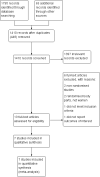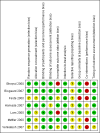Trocar types in laparoscopy
- PMID: 26676093
- PMCID: PMC11227320
- DOI: 10.1002/14651858.CD009814.pub2
Trocar types in laparoscopy
Abstract
Background: Laparoscopic surgery has led to great clinical improvements in many fields of surgery; however, it requires the use of trocars, which may lead to complications as well as postoperative pain. The complications include intra-abdominal vascular and visceral injury, trocar site bleeding, herniation and infection. Many of these are extremely rare, such as vascular and visceral injury, but may be life-threatening; therefore, it is important to determine how these types of complications may be prevented. It is hypothesised that trocar-related complications and pain may be attributable to certain types of trocars. This systematic review was designed to improve patient safety by determining which, if any, specific trocar types are less likely to result in complications and postoperative pain.
Objectives: To analyse the rates of trocar-related complications and postoperative pain for different trocar types used in people undergoing laparoscopy, regardless of the condition.
Search methods: Two experienced librarians conducted a comprehensive search for randomised controlled trials (RCTs) in the Menstrual Disorders and Subfertility Group Specialised Register, Cochrane Central Register of Controlled Trials (CENTRAL), MEDLINE, EMBASE, PsycINFO, CINAHL, CDSR and DARE (up to 26 May 2015). We checked trial registers and reference lists from trial and review articles, and approached content experts.
Selection criteria: RCTs that compared rates of trocar-related complications and postoperative pain for different trocar types used in people undergoing laparoscopy. The primary outcomes were major trocar-related complications, such as mortality, conversion due to any trocar-related adverse event, visceral injury, vascular injury and other injuries that required intensive care unit (ICU) management or a subsequent surgical, endoscopic or radiological intervention. Secondary outcomes were minor trocar-related complications and postoperative pain. We excluded trials that studied non-conventional laparoscopic incisions.
Data collection and analysis: Two review authors independently conducted the study selection, risk of bias assessment and data extraction. We used GRADE to assess the overall quality of the evidence. We performed sensitivity analyses and investigation of heterogeneity, where possible.
Main results: We included seven RCTs (654 participants). One RCT studied four different trocar types, while the remaining six RCTs studied two different types. The following trocar types were examined: radially expanding versus cutting (six studies; 604 participants), conical blunt-tipped versus cutting (two studies; 72 participants), radially expanding versus conical blunt-tipped (one study; 28 participants) and single-bladed versus pyramidal-bladed (one study; 28 participants). The evidence was very low quality: limitations were insufficient power, very serious imprecision and incomplete outcome data. Primary outcomesFour of the included studies reported on visceral and vascular injury (571 participants), which are two of our primary outcomes. These RCTs examined 473 participants where radially expanding versus cutting trocars were used. We found no evidence of a difference in the incidence of visceral (Peto odds ratio (OR) 0.95, 95% confidence interval (CI) 0.06 to 15.32) and vascular injury (Peto OR 0.14, 95% CI 0.0 to 7.16), both very low quality evidence. However, the incidence of these types of injuries were extremely low (i.e. two cases of visceral and one case of vascular injury for all of the included studies). There were no cases of either visceral or vascular injury for any of the other trocar type comparisons. No studies reported on any other primary outcomes, such as mortality, conversion to laparotomy, intensive care admission or any re-intervention. Secondary outcomesFor trocar site bleeding, the use of radially expanding trocars was associated with a lower risk of trocar site bleeding compared to cutting trocars (Peto OR 0.28, 95% CI 0.14 to 0.54, five studies, 553 participants, very low quality evidence). This suggests that if the risk of trocar site bleeding with the use of cutting trocars is assumed to be 11.5%, the risk with the use of radially expanding trocars would be 3.5%. There was insufficient evidence to reach a conclusion regarding other trocar types, their related complications and postoperative pain, as no studies reported data suitable for analysis.
Authors' conclusions: Data were lacking on the incidence of major trocar-related complications, such as visceral or vascular injury, when comparing different trocar types with one another. However, caution is urged when interpreting these results because the incidence of serious complications following the use of a trocar was extremely low. There was very low quality evidence for minor trocar-related complications suggesting that the use of radially expanding trocars compared to cutting trocars leads to reduced incidence of trocar site bleeding. These secondary outcomes are viewed to be of less clinical importance.Large, well-conducted observational studies are necessary to answer the questions addressed in this review because serious complications, such as visceral or vascular injury, are extremely rare. However, for other outcomes, such as trocar site herniation, bleeding or infection, large observational studies may be needed as well. In order to answer these questions, it is advisable to establish an international network for recording these types of complications following laparoscopic surgery.
Conflict of interest statement
The authors do not have any potential conflicts of interest.
Figures


























Update of
- doi: 10.1002/14651858.CD009814
References
References to studies included in this review
Bhoyrul 2000 {published and unpublished data}
-
- Bhoyrul S, Payne J, Steffes B, Swanstrom L, Way LW. A randomized prospective study of radially expanding trocars in laparoscopic surgery. Journal of Gastrointestinal Surgery 2000;4:392‐7. - PubMed
Bisgaard 2007 {published and unpublished data}
Feste 2000 {published and unpublished data}
Hamade 2007 {published data only}
Lam 2000 {published and unpublished data}
-
- Lam TYD, Lee SW, So HS, Kwok SPY. Radially expanding trocar: a less painful alternative for laparoscopic surgery. Journal of Laparoendoscopic & Advanced Surgical Techniques 2000;10(5):269‐73. - PubMed
Mettler 2000 {published and unpublished data}
-
- Mettler L, Maher P. Investigation of the effectiveness of the radially‐expanding needle system, in contrast to the cutting trocar in enhancing patient recovery. Minimally Invasive Therapies & Allied Technologies 2000;9(6):397‐401.
Venkatesh 2007 {published and unpublished data}
References to studies excluded from this review
Herati 2011 {published data only}
-
- Herati AS, Andonian S, Rais‐Bahrami S, Atalla MA, Srinivasan AK, Richstone L, et al. Use of the valveless trocar system reduces carbon dioxide absorption during laparoscopy when compared with standard trocars. Urology 2011;77(5):1126‐32. - PubMed
Huang 2012 {published data only}
-
- Huang SY, Wang SY, Yeh CN, Cheng CT, Tsai CY, Liu YY, et al. Bladeless trocar versus traditional trocar for patients undergoing laparoscopic cholecystectomy. European Surgery 2012;44:408‐12.
Stephanian 2007 {published data only}
-
- Stephanian AA, Winer WK, Isler CM, Lyons TL. Comparative analysis of 5‐mm trocars: dilating tip versus non‐shielded bladed. Journal of Minimally Invasive Gynecology 2007;14:176‐83. - PubMed
Tansatit 2006 {published data only}
-
- Tansatit T, Wisawasukmongchol W, Bunyavejchevin S. A randomized, prospective study comparing the use of the missile trocar and the pyramidal trocar for laparoscopy access. Journal of the Medical Association of Thailand 2006;89(7):941‐7. - PubMed
Tchartchian 2010 {published data only}
Yim 2001 {published data only}
-
- Yim SF, Yuen PM. Randomized double‐masked comparison of radially expanding access device and conventional cutting tip trocar in laparoscopy. Obstetrics and Gynecology 2001;97(3):435‐8. - PubMed
Additional references
Ahmad 2015
Antoniou 2013
-
- Antoniou SA, Antoniou GA, Koch OO, Pointner R, Granderath FA. Blunt versus bladed trocars in laparoscopic surgery: a systematic review and meta‐analysis of randomized trials. Surgical Endoscopy 2013;27:2312‐20. - PubMed
Cardin 2011
-
- Cardin JL, Johanet H, Club Coelio. Intraoperative events and their outcome: data from 4007 laparoscopic interventions by the French "Club Coelio". Journal of Visceral Surgery 2011;148:e299‐310. - PubMed
Champault 1996
-
- Champault G, Cazacu F, Taffinder N. Serious trocar accidents in laparoscopic surgery: a French survey of 103,852 operations. Surgical Laparoscopy and Endoscopy 1996;6:367‐70. - PubMed
DeSimone 2008
-
- DeSimone CP, Ueland FU. Gynecologic laparoscopy. Surgical Clinics of North America 2008;88:319‐41. - PubMed
Fuller 2003
-
- Fuller J, Scott W, Ashar B, Corrado J. Laparoscopic trocar injuries: a report from a U.S. Food and Drug Administration (FDA) Center for Devices and Radiological Health (CDRH) Systematic Technology Assessment of Medical Products (STAMP) committee, 2003. www.fda.gov/MedicalDevices/Safety/AlertsandNotices/ucm197339.htm (accessed 10 November 2015).
Fuller 2005
-
- Fuller J, Ashar BS, Carey‐Corrado J. Trocar‐associated injuries and fatalities: an analysis of 1399 reports to the FDA. Journal of Minimally Invasive Gynecology 2005;12:302‐7. - PubMed
Garry 1999
-
- Garry R. Towards evidence‐based laparoscopic entry techniques: clinical problems and dilemmas. Gynecological Endoscopy 1999;8:315‐26.
GRADEpro [Computer program]
-
- McMaster University. GRADEpro. McMaster University, 2014.
Gurusamy 2013
Guyatt 2008
Higgins 2011
-
- Higgins JPT, Green S (editors). Cochrane Handbook for Systematic Reviews of Interventions Version 5.0.1 [updated March 2011]. The Cochrane Collaboration, 2011. Available from www.cochrane‐handbook.org.
Hulka 1977
-
- Hulka JF. Current status of elective sterilizations in the United States. Fertility and Sterility 1977;28:515‐20. - PubMed
Jansen 1997
-
- Jansen FW, Kapiteyn K, Trimbos‐Kemper T, Hermans J, Trimbos JB. Complications of laparoscopy: a prospective multicentre observational study. British Journal of Obstetrics and Gynaecology 1997;104:595‐600. - PubMed
Jansen 2004
-
- Jansen FW, Kolkman W, Bakkum EA, Kroon CD, Trimbos‐Kemper TC, Trimbos JB. Complications of laparoscopy: an inquiry about closed‐ versus open‐entry technique. American Journal of Obstetrics and Gynecology 2004;190(3):634‐8. - PubMed
Kadar 1993
-
- Kadar N, Reich H, Liu CY, Manko GF, Gimpelson R. Incisional hernias after major laparoscopic gynecologic procedures. American Journal of Obststrics and Gynecology 1993;168:1493‐5. - PubMed
Kulier 2004
Leibl 1999
-
- Leibl BJ, Schmedt C, Schwarz J, Kraft K, Bittner R. Laparoscopic surgery complications associated with trocar tip design: review of literature and own results. Journal of Laparoendoscopic and Advanced Surgical Techniques 1999;9(2):135‐40. - PubMed
Leibl 2001
-
- Leibl BJ, Kraft K, Schmedt CG, Bittner R. Access techniques for endoscopic surgery ‐ types of trocars, ports and cannulae ‐ an overview. Minimally Invasive Therapies & Allied Technologies 2001;10(1):5‐10. - PubMed
Medeiros 2009
Metwally 2012
Moris 2012
-
- Moris DN, Bramis KJ, Mantonakis EI, Papalampros EL, Petrou AS, Papalampros AE. Surgery via natural orifices in human beings: yesterday, today, tomorrow. American Journal of Surgery 2012;204(1):93‐102. - PubMed
Rao 2011
RevMan 2014 [Computer program]
-
- The Nordic Cochrane Centre, The Cochrane Collaboration. Review Manager (RevMan). Version 5.3. Copenhagen: The Nordic Cochrane Centre, The Cochrane Collaboration, 2014.
Sajid 2009
-
- Sajid MS, Khan MA, Ray K, Cheek E, Baig MK. Needlescopic versus laparoscopic cholecystectomy: a meta‐analysis. ANZ Journal of Surgery 2009;79(6):437‐42. - PubMed
Swank 2012
-
- Swank HA, Mulder IM, Chapelle CF, Reitsma JB, Lange JF, Bemelman WA. Systematic review of trocar‐site hernia. British Journal of Surgery 2012;99(3):315‐23. - PubMed
Ternamian 1998
-
- Ternamian AM. A trocarless, reusable, visual‐access cannula for safer laparoscopy; an update. Journal of the American Association of Gynecologic Laparoscopists 1998;5(2):197‐201. - PubMed
Thakur 2011
-
- Thakur V, Schlachta CM, Jayaraman S. Minilaparoscopic versus conventional laparoscopic cholecystectomy a systematic review and meta‐analysis. Annals of Surgery 2011;253(2):244‐58. - PubMed
Vilos 2007
-
- Vilos GA, Ternamian A, Dempster J, Laberge PY, The Society of Obstetricians and Gynaecologists of Canada. Laparoscopic entry: a review of techniques, technologies, and complications. Journal of Obstetrics Gynaecology Canada 2007;29(5):433‐56. - PubMed
Publication types
MeSH terms
LinkOut - more resources
Full Text Sources
Medical

